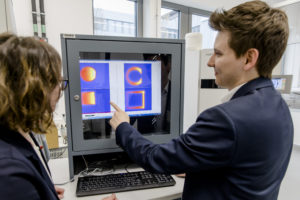Process Analysis / Simulation
Process Analysis / Simulation

The process of selective laser melting can be divided into three sub-processes: material application, energy application and material consolidation. First, by means of a roller or a doctor blade system, the application of a powder layer in the construction space takes place, which is then heated up to just below the melting point of the material. A CO2 laser then illuminates the melted cross section of the component. The surrounding powder remains loose and serves as a support structure. The space decreases after the exposure process to the thickness of a layer, usually 100 microns, and a new powder application begins. This process is repeated until the entire part is successively constructed. Only after all the layers of the component have been generated is the powder cake with the internal components cooled.
The properties of beam-molten components, such as the density, surface topography, detail and contour accuracy, are determined by the interaction of the material with the processing parameters. In addition to the application behavior of different powders and the resulting packing density, the temperature control as well as the energy input play a significant role in the part production.
